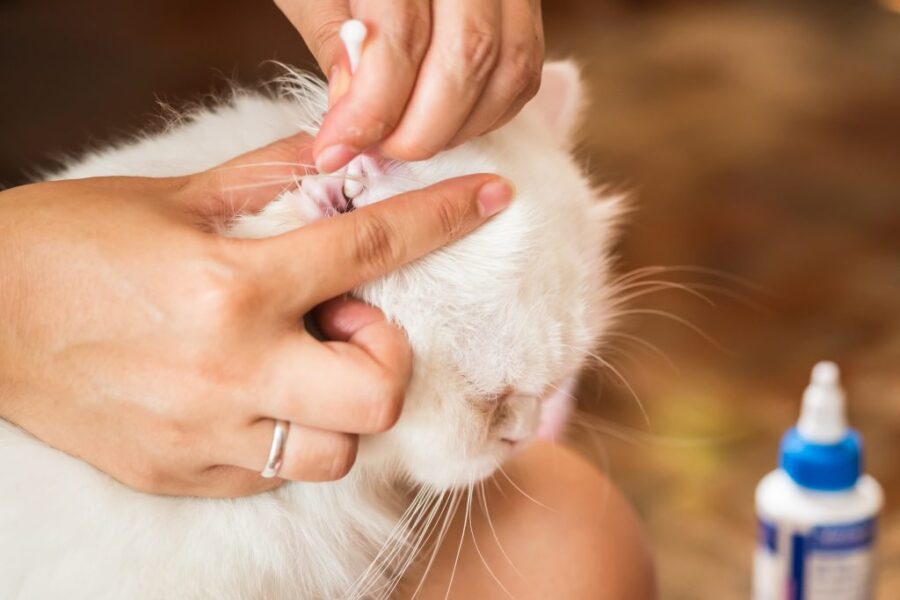A cat suffering from an ear infection usually behaves differently, he will scratch the ear a lot and shake his head. The ear may look warm and swollen with a lot of earwax and it hurts to touch. cat ear infection can have various causes, such as irritation by, for example, hair, increased humidity, or a reduced resistance.
If you suspect that your cat is suffering from an ear infection, it is advisable to consult a veterinarian. Depending on the cause of the problem, treatment will usually consist of cleaning the ear to a course of antibiotics.
How Cat Ear Infection Develops
Just like in humans, all kinds of micro-organisms such as bacteria and fungi live on the skin in a cat’s ear. This is very normal and they live in a certain balance so that there are no complaints. As soon as the balance is disturbed, problems such as an ear infection can arise. For example, an ear mite can disrupt this natural balance.
Reading Suggestions: Boy Cat Names – Find the Perfect Male Kitten Name
More earwax is created, which is a perfect breeding ground for micro-organisms. An overgrowth of this micro-organism can occur, causing an infection. Usually, only the outer ear is affected, but it can penetrate further in, causing a middle ear infection or even meningitis. There are two types of ear infections:
Dry Ear Infection
Usually in this case there is an inflammation of the external auditory canal (the pinna). The inside of the pinna is red and maybe scaly. A waxy substance can often be seen in the ear.
Wet Ear Infection
The inflammation is deep in the ear and sometimes pus comes out. A large number of bacteria and/or fungi have developed.
Main Factors Behind Cat Ear Infections
The balance can be disrupted for various reasons. Many hairs can irritate the ear canal, causing more wax to build up. This is not a problem for most breeds. In sweltering weather, bacteria can multiply quickly in the ear. Sometimes the irritation can arise when the ear is cleaned,
where you irritate the ear from the inside with a cotton swab. When the animal has a reduced resistance, micro-organisms are more likely to strike. Old animals and very young animals are more susceptible to this.
The Complaints
Ear infections usually cause a lot of discomfort. The animal behaves differently, often scratching its affected ear a lot and shaking its head. The cat can rub its head against objects and when touched it shows that it does not like it. The ears may be red, warm, and swollen.
Reading Suggestions: Cat Ear Wax Color Chart
There is often a lot of earwax in the ear canal and that can smell unpleasant. Sometimes some pus can be seen and ulcers and abscesses can form on the pinna. The more severe the inflammation, the worse the symptoms are. An ear infection can lead to deafness or brain symptoms if left untreated.
The Diagnose
It is better to always go to the vet with an ear infection. An untreated ear infection can cause permanent damage to the ear. The vet will check whether the eardrums are still intact. An eardrum is a membrane between the outer and inner ear. If it is damaged, no ear cleaner should be used.
When there is a lot of earwax, the vet will first clean the ear with water to see if the eardrum is still intact. Sometimes the cat is put under anesthesia for this because it is not a pleasant examination.
Cat Ear Infection Treatment
If the eardrums are not damaged, an ear cleaner or ear ointment will usually suffice. In case of a middle ear infection, the cat will be given antibiotics and possibly some painkillers. If the inflammation returns regularly,
the vet will sometimes decide to investigate further. Some samples can then be taken from the ear canal and examined in the laboratory. Then it can be determined which micro-organism is exactly responsible for the ear infection. After the treatment,
some more dirt may come out of the ears in the first days, after that the ears should become cleaner. Furthermore, the scratching and the smell will decrease
Cat Ear Infection Medicine
Cat ear infections are a common health issue that many cat owners encounter. These infections can be caused by various factors such as bacteria, yeast, allergies, or ear mites. If left untreated, these infections can cause severe discomfort, hearing loss, and in rare cases, even result in a life-threatening condition. Fortunately, there are many medications available that can effectively treat cat ear infections.
When it comes to treating a cat ear infection, it is crucial to consult with a veterinarian to identify the underlying cause of the infection. Once the cause is determined, the veterinarian will recommend an appropriate treatment plan, which may include antibiotics, antifungal medications, or ear drops.
Some common medications used to treat cat ear infections include
- Otomax
- Tresaderm
- Mometamax
- Revolution
It is essential to follow the veterinarian’s instructions and complete the full course of treatment to ensure that the infection is fully resolved. Additionally, regular ear cleaning and maintenance can help prevent future ear infections and keep your furry friend healthy and happy.










